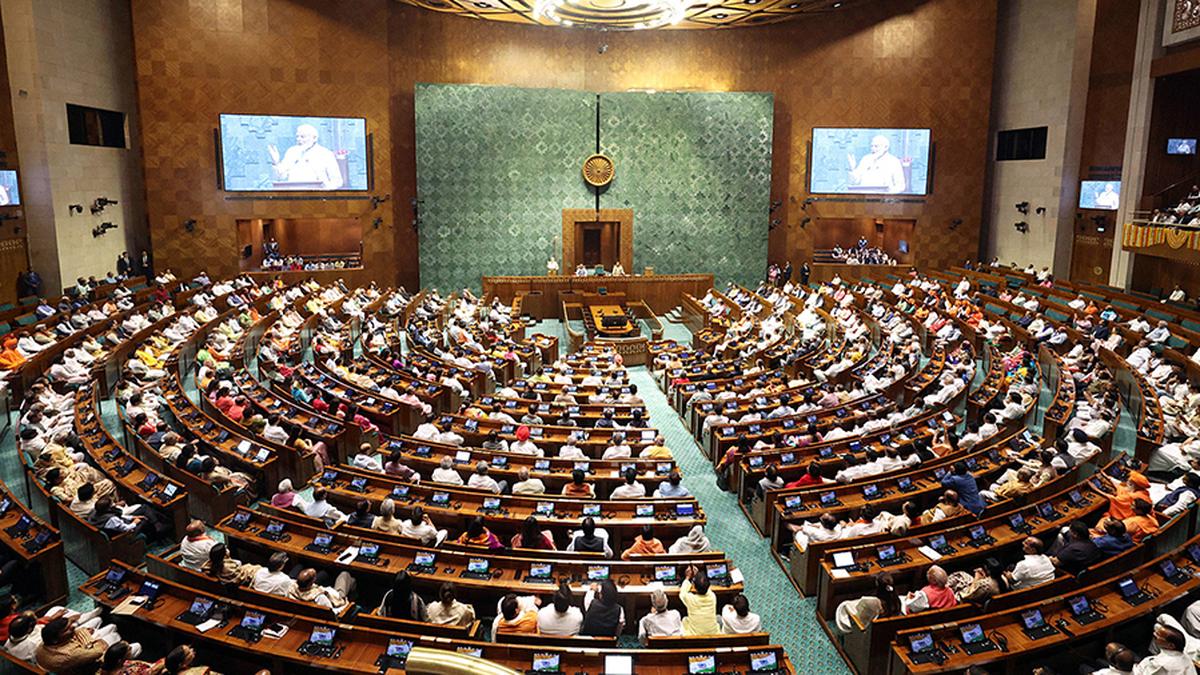Prime Minister Narendra Modi addresses at the inauguration ceremony of the new Parliament House, in New Delhi.
| Photo Credit: ANI
The Joint Action Committee, formed by the southern States, has demanded that delimitation be deferred by another 25 years or delinked from population. Though the Centre remains tight-lipped about the delimitation formula and timeline, the southern States are anticipating the worst-case scenario.
If the Centre opts for State-wise population growth as the sole or major criterion, it will compromise the interests of these States, which have implemented the family planning programme in all sincerity. Deferring is also not ideal, as there is no guarantee that we will not face the same issue after 25 years. This analysis tries to understand the apprehensions of the southern States vis-à-vis the formula of the Delimitation Commission.

Southern States fear that their role in lawmaking will decrease if population growth is used for delimitation. The argument that delimitation would be on a pro-rata basis and that these States would not lose a single seat is not convincing. Merely retaining the existing number of seats or seeing a small increase will not assuage their fears. They are concerned that their populous counterparts would bag a disproportionate number of seats.
On the other hand, the Centre cannot ignore the need to enhance the number of MPs, which has been frozen since 1973. It is important to respect the constitutional spirit of one person, one vote. Even if the Centre freezes delimitation for another 25 years, there is no guarantee of achieving a uniform population growth rate across States, as it depends on several factors such as economy, religious beliefs and geography. Delinking delimitation from population growth, as requested by some States, is also not a tenable proposition, since population is the foundational criterion for delimitation under Article 81(2)(a).
As per reports, the Centre is looking to increase the 543 seats to 753, based on a State-wise population growth formula. The MP seats for populous States such as Uttar Pradesh, Madhya Pradesh, Bihar and Rajasthan would rise from 174 to 249. The seats of the five southern States — Tamil Nadu, Karnataka, Kerala, Telangana and Andhra Pradesh — would only slightly increase from 129 to 144.
With this estimation, the Centre has reasons to consider the interests of the southern States. First, the Centre is duty-bound to ensure fair representation and cannot afford to hurt the sentiments of an entire region. Second, in today’s charged political climate, every decision is met with suspicion and dispute. If the Centre goes ahead with the State-wise population formula, it risks creating sharp disparities within the country’s polity. The south Indian States would feel that their progress has worked against their prospects and rendered them less significant.
There are three approaches for delimitation using population growth, as mandated in Article 81(2)(a). India’s population grew by 153% between 1971 and 2021. If this number is taken as the basis, the Lok Sabha seats will go up to 1,374, and the House becomes unwieldy. The average annual growth rate over the five decades is 1.94%, and increasing the number of seats by this number does not make sense. The third option is the Decadal Growth Average (DGA) formula. If we average the growth rates of five decades between 1971 and 2021, we get 20.91%. If this number is used, the seats will go up to 656, which is a reasonable number. I propose that the Centre should use the DGA.
Unlike the State-wise population growth model, it does not penalise States that have effectively controlled their population. Since the DGA transfers the impact of population growth equally across all States, it eliminates the need for applying other weightage factors such as population control, literacy rate, economic growth rate, etc. If the Centre has to assign weightages, that process could lead to disputes.
The table shows the State-wise share of growth in Lok Sabha seats using the Decadal Growth Average formula
Using the DGA formula would allow the Centre to safeguard the interests of all States while recognising both population growth and development. The only requirement would be to amend Article 81(2)(a), which currently mandates that Lok Sabha seat allocation be proportional to each State’s population, ensuring equal representation per member. This requirement of proportionality to the population is not paramount in the current context for three reasons.
First, for decades, increasing the number of MP seats in line with population growth was considered impractical due to vast disparities in State-wise population growth rates, ranging from minimal to explosive. That is why there has been a more than five-decade embargo. Second, the Centre could amend Article 81 to protect the interests of all the States. Third, different States having different population ratios per MP seat is not a problem. It is often the geography that poses challenges to the MPs rather than the population. For instance, the Lakshadweep parliamentary constituency has only about 80,000 people, but to meet them, their MP needs to travel to several islands, whereas the MP of Malkajgiri constituency, the most populous Lok Sabha constituency in the country, can reach out to more than 45 lakh people very easily.
By adopting the DGA formula for enhancing Lok Sabha constituencies, the Centre can address regional concerns and uphold the principles of federalism. This formula would also pave the way for future delimitations without any disputes or protests.
The author was a former Officer on Special Duty to ex-Chief Minister of Andhra Pradesh, Y.S. Jagan Mohan Reddy
Also read: Delimitation debate: A conflict between the principle of democracy and one of federalism
Published – April 22, 2025 05:02 pm IST
